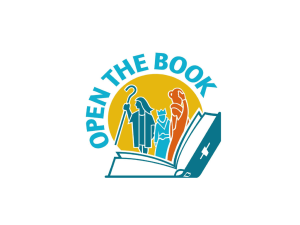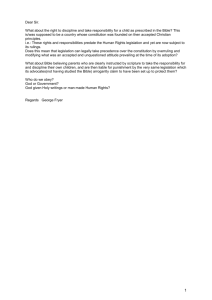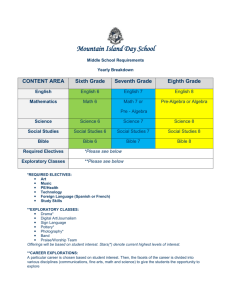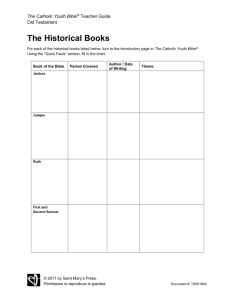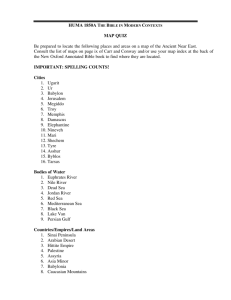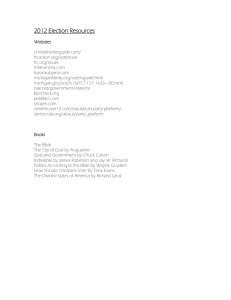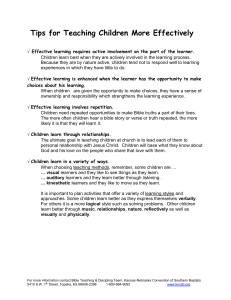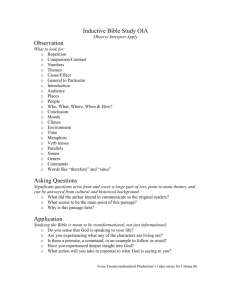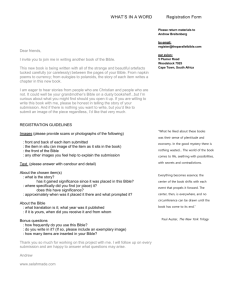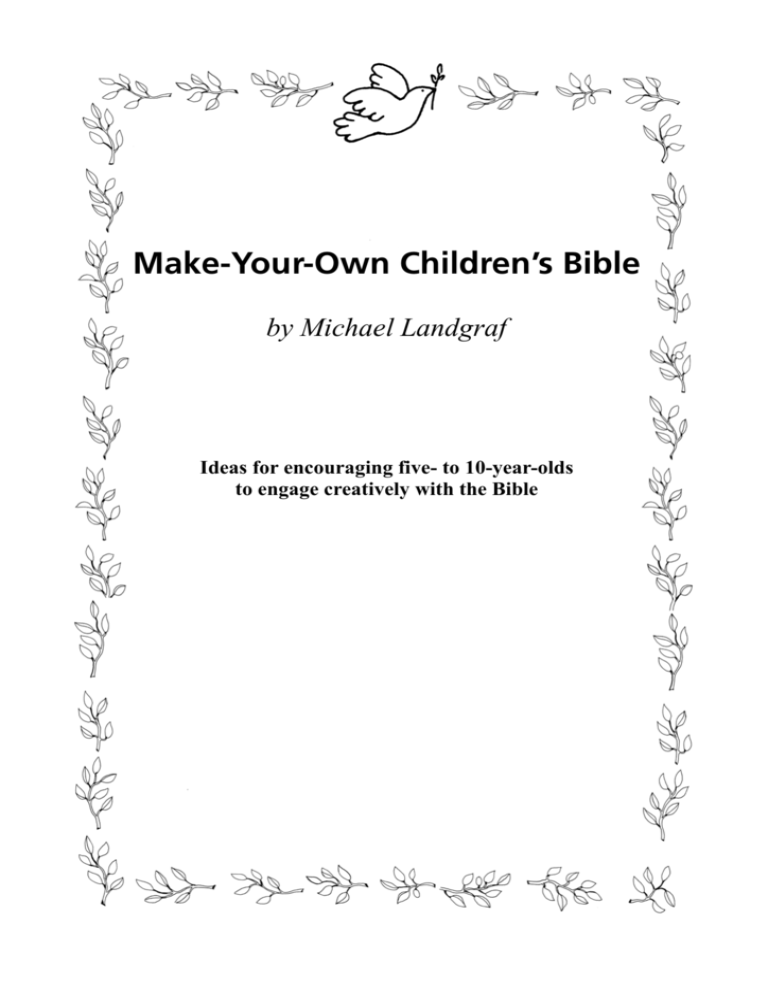
Make-Your-Own Children’s Bible
by Michael Landgraf
Ideas for encouraging five- to 10-year-olds
to engage creatively with the Bible
Contents
1. Introduction ........................................................ 3
a) Colouring Bibles....................................... 3
b) ‘Free’ drawing .......................................... 3
c) The Make-Your-Own Children’s Bible...... 3
2. Preparing the lessons:
guidelines for teachers..................................... 4
2.1 Becoming familiar with Bible texts................. 4
2.2 Telling a Bible Story ....................................... 4
a) Introduction .............................................. 4
b) A guide for telling a Bible story ............... 5
3. Working with the Make-Your-Own
Children’s Bible................................................... 6
3.1 The concept ..................................................... 6
a) The drawings ............................................ 6
b) The text..................................................... 9
3.2 Using the Make-Your Own Children’s Bible ...10
a) Different applications in religious
education .................................................. 10
b) Examples of use........................................ 11
c) Ways of working and presentation
of completed pages ................................... 14
© 2007 by Calwer Verlag, Stuttgart and
German Bible Society, Stuttgart
All rights reserved.
Translator: Mary Frank
Typesetting: NagelSatz, Reutlingen
Produced by: Karin Klopfer, Calwer Verlag
www.calwer.com
www.die-bibel.de
4. Creative approaches to teaching
Bible stories......................................................... 15
4.1 Using drama to present Bible stories............... 15
a) Single pictures (slide or statue)
or a series of pictures (slideshow) ............ 15
b) Mime, role play, stick figures,
shoe box theatre........................................ 15
4.2 Bible stories as rap songs ................................ 15
4.3 Meditations on Bible stories............................ 15
a) An imaginative journey into Bible
stories ....................................................... 15
b) Written meditation.................................... 16
c) Meditation based on symbols ................... 16
d) Writing prayers based on Bible
stories ....................................................... 16
e) Writing psalms.......................................... 16
4.4 Games based on the stories in the
Make-Your-Own Children’s Bible ................... 16
Multi-purpose cards ........................................ 18
1. Introduction
There are many ways to engage creatively with the
Bible. As parents, school teachers and Sunday
School teachers know, children aged between five
and 10 need to be offered a wide range of approaches to help them to fully understand Bible
stories. Children in this age group vary greatly in
ability, so it is helpful to consider the many ways in
which music, drama and, in particular, art can be
used to bring Bible stories to life.
The Make-Your-Own Children’s Bible is designed
as a resource for an approach using creative art. A
brief explanation appears below of how this approach differs from other methods of presenting
Bible stories creatively. These methods generally
involve either colouring in or ‘free’ drawing. Both
have benefits and disadvantages.
a) Colouring Bibles
Bibles containing pictures to colour in recognise
that younger primary-age children (three-eight)
have limited reading and drawing abilities. These
Bibles present Bible stories as outline drawings
which children can turn into coloured pictures using
felt tip pens, wax crayons or paints. This approach
dates back several centuries and today there are
many such products on the market. There are significant differences between these products in terms
of their theological accuracy, their design and the
degree to which they seek to educate.
The benefits of colouring Bibles include:
• They require little preparation by teachers or
parents
and to ‘indescribable creatures’ such as angels, but
also in relation to scenes. Even the artist’s brushstroke can have a significant influence in pointing a
child’s imagination in a particular direction.
b) ‘Free’ drawing
The alternative to Bibles containing pictures to
colour in is ‘free’ drawing of scenes from Bible
stories. However, it has been observed in recent
years that, as well as younger primary-age children
(five to eight years) having limited artistic skills,
those of older children (eight to 11 years) seem to
be declining. As a result of increased media exposure and the decline in traditional leisure activities
such as painting and drawing, children are finding it
increasingly difficult to convey stories and scenes
in pictures. The work of children aged between
eight and 10 shows significant variations in artistic
ability. Some 10-year-olds, for example, still draw
stick people and find it hard to present stories in
picture form.
c) The Make-Your-Own Children’s Bible
The Make-Your-Own Children’s Bible offers an
alternative to colouring Bibles and is designed to
help both younger children and older children who
have limited artistic abilities. It presents key symbols from Bible stories and, through its combination of a creative approach and reliable text, helps
children to focus on specific aspects of selected
Bible stories.
• They encourage children to think in depth about
Bible stories
• They offer a clear and complete creative concept
There are many such products for teachers to
choose from, and this can be very helpful in reducing the preparation time required for school or Sunday School lessons.
The disadvantages of colouring Bibles stem from
the fact that they can restrict children’s creativity.
This can be seen in particular in relation to faces
3
2. Preparing the lesson: guidelines for teachers
The Make-Your-Own Children’s Bible contains
short texts which can be read by or to children. As
part of your preparation, you should read the complete texts in a conventional Bible and a Children’s
Bible so that you are fully familiar with them.
2.1 Becoming familiar with Bible texts
With some parts dating back more than 2,000 years,
Bible stories and texts contain messages from and
for another world. You need to take time to discover
and understand them. The texts are not only messages from the past: they are also relevant for today
and for the future, prompting people to think and
giving them guidance.
The following steps can help in becoming familiar
with Bible texts:
Reading
Reading requires time and a quiet atmosphere. Try
to clear your head before you start, so that you can
concentrate. You may choose to read the text
through twice or to read it in small sections. Ideally, you need to read the text in such a way that you
will be able to explain it to others afterwards, so
you should identify a headline and key points.
Understanding
You need to be open to the message of the text.
Consider what is new to you and what is familiar.
Which parts attract your attention? Where does
the text ask you to make choices? What does it say
about God and the world?
Thinking
The Bible points to the future. Where does the text
express hope? What role does this hope play in
your own future and that of the world as a whole?
Does the text give guidance about your own behaviour?
Consult other people if questions arise during the
preparation of the lesson.
4
Questions about the text
Relating to the text
How do I feel about the text?
Are there things I don’t understand?
What questions do I have about the text?
What impact does it have on me?
How do I respond?
The content
What is happening in the text?
Is it talking about an event, a conversation, a law?
Who or what appears in the text?
Is the text asking a question?
The form
How is the story told (tension, facts, imagery, in
the first person or from a distance)?
What forms of text are present (story, poem)?
The intention
What is the text’s intention (telling a story, teaching, explanation)?
Is there evidence of a particular reason for the text
having been handed down?
What is the response that the text is seeking to
encourage?
2.2 Telling a Bible story
a) Introduction
It is important to prepare thoroughly for telling a
Bible story. But there is no need to feel anxious:
with good preparation and a little courage, everybody can tell a Bible story successfully. The most
important issue is how closely to adhere to the text.
How much should you embellish the story? The
best approach is to stay as close to the text as possible yet be as free as necessary.
You should first try to understand the text, to identify its core message and to follow its structure.
Then think about drawing children in by using storytelling language: short sentences that create excitement combined with snippets of dialogue. Find
a narrative perspective: are you somebody who is
writing down the story or a reporter looking at
things objectively? It is also important to prepare
for the narrative journey. Children aged between
five and seven in particular need to be guided into a
story. An imaginative journey can help with this, as
can dividing the story into sketches. The introduction and significant transition points can be written
down. You can also consider using pictures, background music and figures.
b) A guide for telling a Bible story
The following steps provide guidance for preparing to tell a story
People
Time
The storyteller must try to make the characters
come to life.
• When preparing and telling the story, imagine
real people: an old man, a young girl, whoever
appears in the story. Describe their hair, their
facial expressions, how they walk. This allows
characters to express themselves.
• Make each character’s role clear: a main character, a minor character or just an extra?
• Make it clear how each character behaves.
Describe what they do, what happens to them
or how they react.
• What do the characters think and feel? The storytelling can include inner dialogue and typical
human reactions.
Periods of time play an important role in understanding a story
• Children find it difficult to understand a particular period in history. It can help to explain
that there were no cars, no running water and
no electricity.
• Particular times of day or times of year can
create an atmosphere. Is the sun high in the sky
or is it evening? Is there a mist over the fields?
Details like this can really bring a story to life.
Place
A description of the surroundings will give listeners a sense of place.
• Imagine the place you are trying to describe.
You could consult a picture book or a travel
guide. In the stories about Jesus, for example,
the place could be the banks of Lake Galilee or
Jerusalem. Find out about the surroundings,
about typical plants or the colours of the scenery.
• Include typical sounds, such as the splashing of
water, the noise of a market, the wind blowing
over a field of corn. Smells also form part of
the atmosphere of a place.
Events
A good story is made up of events that flow towards an exciting conclusion.
• The story must be based around a climax. Is it
an event, an action or a pronouncement?
• Each part of the story must build up to the climax. Ensure that there is a smooth transition
from one part to the next.
Core
The core is the most important element of the
story
• What is the story’s core message? What is it
saying to us?
• You should be able to express this message
clearly in a few words. If you can’t do this,
then you are unlikely to be able to tell the story
well.
5
3. Working with the Make-Your-Own-Children’s Bible
3.1 The concept
a) The drawings
The Make-Your-Own Children’s Bible recognises
that younger primary school children have limited
reading and drawing skills. Even older primary
school children sometimes find reading and drawing difficult, so the Make-Your-Own Children’s
Bible uses an approach which is equally suitable for
all primary age-groups. The simple text is based on
early reading principles. The line drawings allow
the book to be used in many different ways.
The concept behind the Make-Your-Own Children’s
Bible stems from well-researched principles which
encourage children’s creativity. The following simplified graphics are used:
• simple faces
• clear basic symbols
• hints of various types of action
• background scenery
• The drawings can be enhanced using coloured
pencils, felt tip pens or wax crayons.
Faces
Faces provide a reference point which children
aged between five and eight in particular still find
helpful. Characters are hinted at through faces
made up of simple lines and dots. Each is given his
or her own personality through features such as a
beard or a crown.
Examples:
Abraham
Sarah
Isaac as an old man
Miriam
Moses
Saul
David
Jonah
Mary
• There are many other creative possibilities.
Children using the Make-Your-Own Children’s
Bible in Sunday Schools have chosen materials
such as wool, tissue paper and coloured paper.
Natural materials like leaves and sand can also
be used.
Jesus
Bartimaeus
the Samaritan
6
an angel
Peter
Zaccheus
Paul
An additional way of presenting faces can be seen
in the case of Joseph, who undergoes a physical
change as he moves from being a shepherd’s son to
a captured slave to the pharoah’s administrator.
Children can show these changes themselves. As a
rich Egyptian, Joseph’s clothing is more noticeable
than his face. This is made clear in the story when
his brothers don’t recognise him.
This approach also includes the ‘dream bubble’
symbol which conveys the pharoah’s dreams or
John’s vision (Revelation).
A musical instrument is shown to convey music
being played, such as Miriam’s song or David playing the harp.
Joseph as a shepherd and a slave
Joseph as the head governor
Some characters are represented by a symbol of
power: the anonymous Egyptian pharaoh in the
story of Joseph and Moses and the soldier at the
arrest of Jesus.
Pharaoh
Simple action symbols are also used to convey violent acts such as the attack on the Egyptian overseer
or David firing a stone from his sling.
Soldier
Other types of people can be represented through
simple symbols, too. For example, shepherds are
represented by a shepherd’s crook.
Basic symbols
In addition to the faces and the symbols conveying
action, the Make-Your-Own Children’s Bible uses
basic symbols which have a clear meaning, such as:
Hints of action
Hints of various types of action are another way to
present the basic elements of a scene. Examples
include:
the handshake between the brothers Jacob and
Esau,
the flower as a symbol of creation (Genesis 1, Psalm 104),
the dove as a symbol of hope
and the spirit of God (Noah’s
ark, the baptism of Jesus),
the large bunch of grapes as a symbol of
the fruitfulness of the promised land
(Numbers 13),
the prophet Elijah’s accusing of King Ahab or the
arrival of Jonah in Nineveh.
the star and the gifts as a symbol of
the Christmas story as told in Matthew’s Gospel (Matthew 2),
7
bread and fish as symbols of the feeding of the
5,000 and bread and a cup as symbols of the meal
with the disciples from Emmaus (Luke 24),
Landscapes and backgrounds
The fourth graphic element which makes up the
Make-Your-Own Children’s Bible concept is simple
background scenery. For example, the beginning of
creation is indicated by a horizontal curve which
provides space for a creative approach to represent
the first two days of creation.
the water jug as a symbol of washing
feet and of serving others (John 13),
the cockerel as a symbol of Peter’s
betrayal and of watchfulness
(Matthew 26).
Further Symbols
Additional graphics are designed to encourage children’s own creative efforts:
The hint of a rainbow at the end of
the story of the flood symbolises
hope and reconciliation (Genesis 9).
The hints of backgrounds are designed to correspond with the various landscapes in the biblical
scenes:
If a story takes place on water, simple lines are used
to represent the banks and the water (eg Moses on
the Nile, the baptism of Jesus).
The pyramids are used to convey scenes in Egypt,
while the city gate indicates Jerusalem.
The bricks indicate oppression and hard work in
Egypt (Exodus 1).
The wave symbolises the passage
through the Red Sea and the rescue
from the returning floods (Exodus
14).
The plinth on which the golden
bull is built stands for the downfall
of the people of Israel.
The vine in the parable of the
workers in the vineyard is designed to encourage children to
draw a vineyard.
The sun rises and sets from the
beginning of creation through to
Revelation and the promised
‘God’s new world’ (Genesis 1–2
to Revelation 21–22). This indicates that God is present at both
the beginning and the end.
8
Rooms are suggested through tents, columns (a
palace), a window or a canopy.
A village or town is shown with a wall or a few
houses and trees.
b) The text
The text of the Make-Your-Own Children’s Bible is
just as important as the drawings. The stories it
contains have been selected to correspond with
primary school and Sunday School curricula. They
are also commonly found in Children’s Bibles.
Backgrounds can also be
basic symbols, such as the
open grave,
the ark or a boat (the stilling of the storm, for
example),
the fish in the story of Jonah,
The stories are told in a short, simple style,
keeping close to the Bible text and avoiding the
embellishments that are often found in Children’s Bibles. The texts get to the heart of even
very detailed stories and yet are written with
early readers in mind. Their simple sentence
structure makes them easy to read.
The texts have been extensively tested in primary schools and Sunday Schools among children aged between five and 10, and have been
assessed and reviewed by school and Sunday
School teachers (see below).
As well as Bible stories, the Make-Your-Own
Children’s Bible contains the Bible’s key texts:
the Ten Commandments (Exodus 20), Psalm 8,
Psalm 23, Psalm 104, Ecclesiastes 3, Isaiah 9
and 11; the Sermon on the Mount (Matthew 5–7:
the Beatitudes, the Fulfilment of the Law, ethical
statements, the Lord’s Prayer, words about worrying), the Great Commission (Matthew 28);
passages from Paul’s letters (Romans 8; 1 Corinthians 13).
The design of the Make-Your-Own Children’s Bible
always takes into account the context in which the
words from the Bible appear.
the Ethiopian official’s chariot
wheel
This is why, for example, the page which presents
the Ten Commandments shows Moses in the margins and Sinai in the background, why Jesus is
shown standing on a hill for the Sermon on the
Mount and why writing implements are shown
when Paul’s letters are presented.
or the tree in the story of
the garden of Eden or the
story of Zaccheus.
9
3.2 Using the Make-Your-Own
Children’s Bible
a) The Make-Your-Own Children’s Bible has many
different applications in religious education:
At home
The Make-Your-Own Children’s Bible is particularly suitable for introducing children to Bible stories at home. For example, it can be used after a
In Sunday School
The Make-Your-Own Children’s Bible is very suitable for use in Sunday School classes. Sunday
School teachers recommend that each child who
regularly attends Sunday School receives their own
copy as a gift from the church. This should be kept
at the church so that it is always available on Sundays, but children who leave the Sunday School
should be allowed to take their copy away. The
benefits of using the Make-Your-Own Children’s
Bible in Sunday Schools are the same as when it is
used in primary schools: a firm basis for teaching
Bible stories which requires no photocopying.
Blackboard Bible
child has read a passage from a Children’s Bible,
either alone or as a shared activity. Children can use
it creatively at home, while its robust construction
allows it to be used on car journeys.
There are many places in the world where it will
not be possible to give each child their own copy of
the Make-Your-Own Children’s Bible. This is particularly true in typical educational settings in Africa, parts of Asia and Latin America. The simple
concept on which this product is based allows it to
be used as a blackboard Bible in both Sunday
Schools and primary schools. The teacher copies
the text and drawings onto the blackboard and the
children copy them in turn into a blank exercise
book. This means that, even in schools with limited
resources, children can produce their own Bible.
In primary school
Teachers recommend that children receive the
Make-Your-Own Children’s Bible as soon as they
start primary school, so that they can work on it
throughout their primary school years. There are
many arguments in favour of this: time-consuming
photocopying is avoided and each child has a book
that can be worked on continuously. When they
leave primary school, they will be able to take with
them a Bible they have made themselves and which
reflects the various stages of their development.
This Bible can form a sound basis for the next stage
in their religious education.
10
Whether they work on it at home, in primary school
or in Sunday School, the Make-Your-Own Children’s Bible allows children to produce something
they will value for the rest of their lives and which
will form the basis for further encounters with the
Bible.
b) Examples of use
The Make-Your-Own Children’s Bible has been tested in a wide variety of contexts. Children in their second or subsequent years at primary school or Sunday school encountered few difficulties with the text. Among children in their
first year, the most common approach was to read the text to them and then
encourage them to repeat it. Both younger children (five-seven) and older
children (eight-10) found the faces, symbols and background scenery helpful.
Faces and figures based on Jesus
Top row: Boy (7) / Boy (8) / Boy (9) / Boy (9) with dark skin
Bottom row: Girl (7) / Girl (8) / German girl of Russian origin (8) who brought a picture of ‘her’ Jesus with
her and glued it in / Boy (10)
11
Examples of angels
As ‘indescribable creatures’, angels present a significant problem in the design of colouring and Children’s
Bibles. These drawings show how many different understandings there are of angels and how readily children engage with the concept behind the Make-Your-Own Children’s Bible.
Top row: Boy (6) / Boy (6) / Girl (8) / Girl (9)
Middle row: Girl (8) / Girl (8) / Girl (10)
Bottom row: Girl (6) / Girl (10)
12
Examples of parables
The parable of the kind father /
the lost son (Luke 15,11–32)
(Make-Your-Own Children’s
Bible, page 127)
The parable of the farmer
(Mark 4)
(Make-Your-Own Children’s
Bible, page 123)
The parable of the workers in
the vineyard (Matthew 20)
(Make-Your-Own Children’s
Bible, page 131)
13
c) Ways of working and presentation
of completed pages
There are a number of possible approaches to working on the pages of the Make-Your-Own Children’s
Bible and presenting the results.
Individual work followed by presentation
during circle time:
Each child completes a page of their Bible. They
then present their work, ideally during circle time.
The children are encouraged to identify similarities
and differences in their interpretation of the Bible
story.
Team work followed by presentation
to the whole group:
An extended story (that of Moses, for example) is
divided between members of the group so that children in groups of two take one page each. The children note their ideas in their Make-Your-Own Children’s Bible and then discuss them together. This
allows them to swap creative ideas about how their
portion of the story could be presented.
Each group then presents its work according to the
order of events in the story.
14
Using PowerPoint to present
the completed pages:
Completed pages are photographed or scanned and
imported into a PowerPoint presentation. This also
makes it possible to show them as part of a larger
event (a school performance, perhaps, or a church
service or community festival).
Making and presenting OHP sheets:
Each child is given a sheet and suitable pens. They
place the sheet over a page in their Bible and trace
round the drawings. Then they continue working on
the sheet with the pens. This method, too, allows
children to present their finished work at special
events or church services.
Making a (shared) blackboard drawing:
Producing a drawing on the blackboard is a particularly useful approach if children do not have a personal copy of the Make-Your-Own Children’s Bible.
Coloured chalk is required. The children can work
together on a shared drawing.
Poster:
A drawing in the Bible can also be converted into
poster format by between four and eight children.
Suitable subjects include representations of Jesus or
of angels.
4. Creative approaches to teaching Bible stories
4.1 Using drama to present Bible stories
Primary school-age children enjoy turning Bible
stories into drama. The text and drawings in the
Make-Your-Own Children’s Bible can be used as
stage directions.
a) Single pictures (slide or statue)
or a series of pictures (slideshow)
A single picture or a series of pictures can be used
as the starting point for a drama. Begin by getting
the children to listen to or read a Bible story and
represent it in their Make-Your-Own Children’s
Bible. Encourage them to think about which picture
is most important for them. Then get them to choose one scene and present it as a drama. Each child
can take a different role: a person, or perhaps a tree,
an animal or an object. Exaggerated arm movements can represent a storm or a smiling face, for
example, and outstretched arms can symbolise the
sun. Children can also be encouraged to use
gestures to convey emotions.
b) Mime, role play, stick figures,
shoe box theatre
Other ways to depict Bible stories through drama
include those with words (role play, musical theatre) and those without words (mime). Both types
can also use stick figures based on drawings in the
Make-Your-Own Children’s Bible. These figures
can be made in several ways, each of which require
strong cardboard.
– Draw faces or whole people from the MakeYour-Own Children’s Bible on large sheets of
paper and let the children work on them. Strands
of wool can be used to make hair. Then cut around the face or person and attach it to a frame
made from one long and one short strip of wood.
The body can be ‘dressed’ with some cloth.
Dialogue or text can be attached to the back of
the figure.
– To make a ‘shoe box theatre’, you need small
copies of the faces and symbols. Glue a stick to
the back. Use a shoe box which is open at the
front and the top to create the backdrop.
4.2 Bible stories as rap songs
Children aged from nine upwards are capable of
converting Bible stories into rap songs, using the
text from the Make-Your-Own Children’s Bible as
their starting point. Ask the children to write a verse
and a chorus in rap rhyming form.
4.3 Meditations on Bible stories
a) An imaginative journey into Bible stories
Younger primary school children have not yet developed any understanding of life in biblical times.
An imaginative journey can help them to become
more familiar with biblical times and the passing of
time since then. For example:
The children sit at their desks. The teacher says,
“We’re going to stand up and get into our time
machine.”
(The children stand up, stand next to their desks
and then sit down again at their desks as if getting into a car.)
“Now it’s getting exciting. We’re going to set off
on our journey through time soon. We’re starting
the engine.”
(The children make the noise of an engine starting.)
“Now we’re pedalling.”
15
(The children move their feet as if riding a
bicycle.)
“We’re closing our eyes and going on our journey through time.”
(The children make a noise that grows louder
and louder.)
point for children to write meditative prayers/texts
(for example, a prayer for the creatures in the ark,
for the clashing brothers Esau and Jacob, for Joseph
in prison, for the ‘lost son’ with the pigs). Prayers
can be written on the back of the page opposite the
story.
The teacher claps once and says,
e) Writing psalms
“Now we’ve arrived in ancient Israel at the time
of Abraham (Moses, Jesus …). We’re getting
out of our time machine.”
Children can also be encouraged to write psalms.
They can use the psalms presented in the MakeYour-Own Children’s Bible as examples.
(The children stand up and get out of the imaginary time machine.)
“There’s a smell of herbs and we can feel a
warm breeze.”
(The teacher has a jar containing basil or Mediterranean herbs which he/she lets the children
smell.)
“We can see people. They’re wearing white
woollen robes and they’re sitting on the ground.
They’re telling each other a story. We’re going
to sit with them and open our eyes.”
(The children open their eyes. They then listen
to the Bible story and replicate it in their MakeYour-Own Children’s Bible.)
b) Written meditation
Many Bible stories contain tension and conflict.
You often ask yourself, “What happened next?”
When the traders take Joseph to Egypt, when
Moses sees the burning bush and is told to return to
Egypt, when Jesus tells the parable of the lost son
and the son, while caring for pigs, asks himself how
he will be received by his father – children can
develop all these scenes further. The simple concept
on which the Make-Your-Own Children’s Bible is
based allows them to do this on a blank page.
c) Meditation based on symbols
After reading a passage from the Make-Your-Own
Children’s Bible, key symbols such as the rainbow
or the star in the Christmas story can be used as the
basis for a meditation.
d) Writing prayers based on Bible stories
Portraying a Bible story creatively in the MakeYour-Own Children’s Bible can serve as a starting
16
4.4 Games based on the stories in the
Make-Your-Own Children’s Bible
Simple multi-purpose cards showing the most important faces and symbols can be used as a refresher, memory or association game, either as a
follow-up to looking at Bible stories during lessons
or at the end of a child’s time at primary school.
To make a memory game, give out two sets of pages from the Make-Your-Own Children’s Bible.
When the children have coloured in, or decorated
the faces and symbols in some other way, laminate
them and cut them into squares. They can then be
used as memory cards.
Instead of using two pictures, you can take one
picture and write the name of the person or symbol
it shows on a second, blank, card.
Another option for older children is an association
game. Give each child five cards. Show one of the
remaining cards. Draw lots to determine who will
tell the story associated with the face or symbol that
appears on this card. This child then places another
card next to the first one. The next child continues
the story and must link it with the previous one.
For example: the card showing a basket (Moses) is
on the table. One player adds the card showing the
pyramids and says, “Another story from Egypt is
the one which tells how Mary, Joseph and Jesus had
to flee to Egypt.”
Other associations might be: “Another story from
the Old Testament is ...” / “Somebody else who was
in danger is ...” / “Another story in which God
helped people is ...” / “Another story in which God
went with people is …”
(Make-Your-Own Children’s Bible, page 55)
17
Multi-purpose cards: symbols (a selection)
18
19
Multi-purpose cards: faces
20
The faces on the cards can be identified with the help of the Make-Your-Own Children’s
Bible.
The blank cards can be used to make missing or additional faces.
Cards for your own use
21

